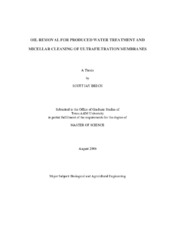| dc.contributor.advisor | Lesikar, Bruce J. | |
| dc.creator | Beech, Scott Jay | |
| dc.date.accessioned | 2006-10-30T23:27:07Z | |
| dc.date.available | 2006-10-30T23:27:07Z | |
| dc.date.created | 2006-08 | |
| dc.date.issued | 2006-10-30 | |
| dc.identifier.uri | https://hdl.handle.net/1969.1/4249 | |
| dc.description.abstract | Produced water is a major waste produced from oil and natural gas wells in the state of Texas. This water could be a possible source of new fresh water to meet the growing demands of the state after treatment and purification. This thesis describes a research project that evaluated the treatment of brine generated in oil fields (produced water) with ultrafiltration membranes. The characteristics of various ultrafiltration membranes for oil and suspended solids removal from produced water were studied to test whether they could be used in a pretreatment method. The research measured the effect of pressure and flow rate on performance of three commercially available membranes for treatment of oily produced water. Oil and suspended solids removal were measured by using turbidity and oil in water measurements taken periodically. The study also analyzed the flux through the membrane and any effect it had on membrane performance. The research showed that an ultrafiltration membrane provided turbidity removal of over 99% and oil removal of 78% for the produced water samples. The results indicated that the ultrafiltration membranes would be useful as one of the first steps in purifying the water. Membrane cleaning of produced water-fouled membranes by micellar solutions was investigated. A neutral pH and ambient temperature micelle solution for effective cleaning of oily water-fouled membranes was developed and studied. The performance of cleaning solutions on ultrafiltration membranes was investigated on laboratory size membrane testing equipment. Different micro emulsion solutions were studied to evaluate the effect of solution properties on cleaning performance. Three types of multiple membranes were studied, each having the same polyvinylidene fluoride (PVDF) material but with different nominal separation or flux characteristics. The data showed that the use of a micelle solution to clean the produced water-fouled membranes was a feasible and effective method. The study showed with further adjustment of the micelle solution the cleaning effectiveness could be optimized to provide double the effectiveness of current industry methods for membranes fouled by produced water. | en |
| dc.format.extent | 487237 bytes | en |
| dc.format.medium | electronic | en |
| dc.format.mimetype | application/pdf | |
| dc.language.iso | en_US | |
| dc.publisher | Texas A&M University | |
| dc.subject | micelle | en |
| dc.subject | ultrafiltration | en |
| dc.subject | produced water | en |
| dc.subject | membrane cleaning | en |
| dc.title | Oil removal for produced water treatment and micellar cleaning of ultrafiltration membranes | en |
| dc.type | Book | en |
| dc.type | Thesis | en |
| thesis.degree.department | Biological and Agricultural Engineering | en |
| thesis.degree.discipline | Biological and Agricutural Engineering | en |
| thesis.degree.grantor | Texas A&M University | en |
| thesis.degree.name | Master of Science | en |
| thesis.degree.level | Masters | en |
| dc.contributor.committeeMember | Burnett, David | |
| dc.contributor.committeeMember | Nikolov, Zivko | |
| dc.type.genre | Electronic Thesis | en |
| dc.type.material | text | en |
| dc.format.digitalOrigin | born digital | en |


